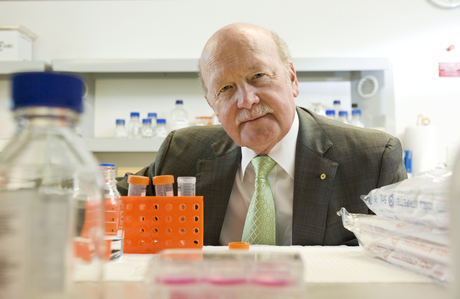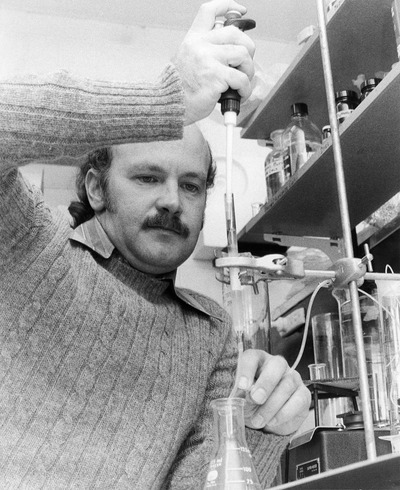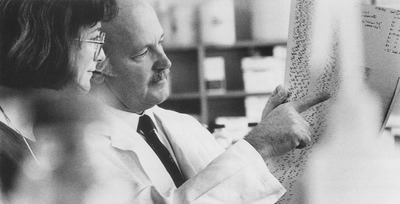Timing it right

John Shine reflects on his impressive career as a research scientist, including a foray or two into the world of biotech and 22 years as head of the Garvan Institute - he says it helped being in the right place at the right time.
Australian Life Scientist: What drew you to science?
Professor John Shine: Well, I’ve always been interested in science and the natural world. As kids growing up my brother and I had a lot of interest in birds and snakes. My brother, who is now Professor of Zoology at Sydney University, pursued the snake stuff more than I ever did.
I went to veterinary science at the age of 16 at Sydney University, which was actually too young. After a couple of years I dropped out, moved to Canberra and enrolled in a science degree part-time while I worked as a technician at the National Biological Standards Laboratories.
I ended up doing biochemistry at the Australian National University (ANU) - which was by the way the subject that I disliked most during vet science - and my lecturer was Lyn Dalgarno. He was an inspirational teacher who was very interested in this new arm of biochemistry, molecular biology, and he got me incredibly interested.
That would have been the late 1960s, when molecular biology was very much in its infancy. And in 1972, when I finished the BSc, I did an honours degree and then a PhD with Lyn Dalgarno as my supervisor.
It was during that period that we discovered what is now known as the Shine-Dalgarno sequence, which was really a big step in my career.
ALS: What led to your discovery of protein termination?
JS: Lyn had found that in insects the large subunit of ribosomal RNA (rRNA) had some sort of break. For this reason, when he extracted the RNA from insect cells he saw only 18s rRNA, whereas mammalian cells have a large and small subunit rRNA, which sediment at around 26s and 18s. It was one of those esoteric odd observations.
So my job, as the honours student, was to investigate that break further. I showed that this was a specific break by sequencing the 3′ end of the RNA. I also found that the 3′ sequence of the smaller 18s rRNA from insects was exactly the same as the mammalian 18s rRNA, which we thought was interesting.
My PhD followed on from that. Very soon it became clear that the 3′ end of the 18s rRNA from insects, worms, rabbits and humans was exactly the same sequence for about the first eight nucleotides coming back from the 3′ end. And given that the rest of the sequence then became quite different, that’s got to be functionally significant.
I still remember thinking about that sequence a lot - GAUCAUUA. One day I was at home and it suddenly dawned on me that the complement of that sequence would be UAAUGA and that’s exactly two of the termination codons, UAA and UGA. UAG, the third termination codon, could also be recognised by the sequence through what’s called “wobble” - a G:U base pair, so that stretch of sequence would be the exact complement to all three termination codons.
As there is no transfer RNA that recognises termination codons, we postulated that the 3′ end of the small rRNA scans the mRNA during translation and upon binding to a termination codon causes a structural change which triggers binding of protein release factors, catalysing release of the completed protein.
It was one of those eureka moments, realising it was the signal that terminates protein synthesis in every organism I had looked at. So we published that in Nature and it was widely accepted.
ALS: That’s a great start. What came next?
JS: Yes, that was my PhD and that was a great moment. The next thing was to look at prokaryotes. So, expecting it to be the same, I sequenced Escherichia coli and found the 3′ sequence of E. coli rRNA was similar but different.
The sequence started out exactly the same, UUA, then the sequence CCUCC, which was totally different, and then came UCA exactly the same as the eukaryotes. I looked at a few other bacteria and they were all pretty much the same.
Up until then the rRNA had been thought of as the scaffolding that held together the proteins that form a ribosome and that’s all. But with this finding we showed that the end of the 18s rRNA scanned the mRNA looking for a termination codon - that was our model of it anyway. And it made me think well, if it’s scanning the mRNA and it’s still doing termination in bacteria, maybe this CCUCC is somehow recognising the initiation point of protein synthesis.
The question about initiation was very topical at the time. It was known that AUG was a start codon and that in eukaryotes the ribosome recognised the first AUG and from then on off it goes.
So I then looked for the complement to the CCUCC sequence. Others, especially Joan Steitz at Yale, who was a leader in this protein initiation field, had published some very nice work determining the sequences, about 30 nucleotides long, around the true AUG starting point in bacterial mRNA.
When I looked at these sequences, I found the complement sequence, GGAGG, about 10 nucleotides back from the AUG. Although it wasn’t quite that simple, there were some that were just GAG or GGAG, and every other permutation. But when I looked at that it was quite amazing - it was like turning the light on.
We submitted it to Proceedings of the National Academy of Sciences and Joan Steitz was a member of the academy. She apparently liked it, because it explained everything she’d been trying to do and she gave it the name the Shine-Dalgarno sequence when she made the commentary.
The bottom line is the Shine-Dalgarno sequence was the signal for the initiation and termination of protein synthesis.
ALS: You were one of the first to successfully clone a human gene, can you describe how your work led to this?
JS: I did the usual thing and wrote off to a dozen labs overseas looking for a postdoc. I was fortunate in that I ended up with three offers that were all good - one in Boston, one in Berlin and the third in San Francisco.
I chose to go to San Francisco, which I think was the best career choice I ever made. It was not because of any scientific insight that I chose San Francisco - Boston was too cold and I don’t speak German, so San Francisco seemed like a great place to go.
I arrived just as the recombinant DNA stuff was starting - life’s all about timing. I went to work in a lab run by Howard Goodman, a biochemist working on RNA and restriction enzymes, at the University of California San Francisco.
I arrived in Goodman’s lab at about the same time as two other postdocs - Axel Ullrich and Peter Seeberg, both from Germany - and Herb Heineker, a postdoc from Holland who was working in a lab headed by Herb Boyer.
The four of us spent a lot of time trying to clone insulin cDNA from an RNA copy. I can still remember picking the X-ray film out of the tank. It was pretty late at night, and I held it up and I could read the sequence, and knowing the amino acid sequence in my head I could instantly recognise that it was insulin. It was the first time anyone had seen the insulin gene - we were at the forefront and that was very exciting.
The end result of that postdoc was that we cloned the first insulin gene, the first human hormone gene (placental lactogen) as well as growth hormone.
ALS: Was there then a natural progression into the biotech and commercialisation?
JS: Up until that point I hadn’t thought about commercialisation. It just wasn’t on my radar. It was all pure, basic, curiosity-driven science. And it was the same for the other postdocs in the lab. Until we cloned the insulin gene I don’t think we even knew what a patent was, it just wasn’t relevant.
However, once we cloned the insulin gene things changed. There was a big need for insulin and that’s why in the early days of the initial cloning experiments the Holy Grail was insulin. That was really my first inklings of the potential of commercialising work.
Genentech was set up out of Herb Boyer’s lab - Herb was the cofounder of the company - and they were very interested in producing and marketing human insulin and human growth hormone. As soon as we announced we’d cloned the insulin gene and published it in Science, Genentech was very keen to work us.
I consulted with Genentech a fair bit. It was very satisfying that the Shine-Dalgarno sequence and the concepts around it became so important in expressing mammalian proteins in bacteria.
That got me quite interested in working with industry because it was real, and it was important for making the final protein.
ALS: Were you tempted to continue working in biotech?
JS: I was tempted. I came back to do research at the Research School of Biological Sciences at the ANU in 1978 and continued cloning various human genes.

Then I went back in 1983. It became clear that not just the commercial side in the recombinant DNA works, but also the academic side was still mostly happening in California - especially in the burgeoning biotech activity over there. Molecular biologists were in high demand.
I had maintained contact with endocrinologist John Baxter, who ran a lab at the University of California San Francisco. John was a typical American MD, very entrepreneurial. He started up a biotech company called California Biotechnology and convinced me to take the position as Director of Research.
I was only going to go for about a year. It ended up being a bit over three years. This was a real learning experience for me in that I went from Director of Research to President of the company in the space of a couple of years.
I was exposed to a lot more of the commercial side of the biotech industry - I would never have gotten that in Australia. CalBio was a science-driven, start-up biotech company but after about three years it had grown from a couple of scientists to a staff of about 300. It was really at a point that it needed a business person to run it, not a scientist. And our children were at an age where if we’d stayed in the US they would have become Americans, so we chose to come back to Australia.
I came back to the Garvan as Deputy Director leading the neuroscience program. Shortly after I got back, the director, Les Lazarus, stepped aside and I was in the right place at the right time again.
ALS: Did you bring that business experience into the directorship at the Garvan?
JS: I think so. I hope so. Back in those early days when biotech was starting in the US, it just really wasn’t in the culture of the Australian scientific community to interact much with industry.
Australian culture was very much the poorer the scientist, the better the science. And there’s a whole bunch of reasons for that - it’s part cultural, part the fact that we haven’t really had a research-based pharmaceutical industry in Australia in the past. We’ve got companies like CSL now, and ResMed, Cochlear, but there’s not many of them.
This has now changed enormously. One of the main things that’s changed is that researchers have seen, especially with the development of biotech, that top science can be done in industry. It became clear that it wasn’t a ‘them and us’.
If you look at a lot of the big biological science breakthroughs over the past couple of decades that you read in Nature or Science or Cell, these have involved researchers associated with, if not full-time employees of, biotech companies.

ALS: Do you have any ideas about what’s next for the Garvan?
JS: I became director in 1990 and was in that role for 22 years - I’ve enjoyed every minute of it. It’s been great to see the institute grow and it’s done incredibly well. But it was certainly time to step down, not just for me but to reinvigorate the institute. It’s a different time now and we’re fortunate to have John Mattick as the new director.
I think that the big genomics, the big databases, the big computer power, having your genome totally sequenced when you’re six months old, that’s the way of the future and Garvan needs to embrace that.
I see this bigger picture perspective of integrating research into the clinical setting as the way forward. Everyone does, translational research, it’s a bit of a buzz word. But the reality is, unlike almost any other time in the history of medical research, the distance between a research discovery and a practical clinical outcome is closer than ever and it’s only going to get more and more so.
The Garvan needs to embrace this; hence, not long before I left we got the new cancer centre underway, the Kinghorn Cancer Centre. It’s really very satisfying to see that finished.
ALS: And you’re back in the lab?
JS: Yes, I’m back. I don't get callouses pipetting anymore but I have a small research group here and am indulging myself as retired scientists do in doing some research. I’m really enjoying it.
Over the past several years I’ve had this small research group and we’ve working with neuronal stem cells, especially olfactory stem cells. I’m looking hard at it now to see how competitive can we really be - even though it’s going well the field is starting to grow rapidly.
I’ve begun collaborating with the head of the renal unit at St Vincent’s, Dr Tim Furlong. Tim worked in my lab at the Garvan years ago and we’ve started to look at developing a genome assessment project for patients with inherited kidney disease who often end up requiring dialysis.
ALS: Do you think discovery research will maintain its place?
JS: A challenge is going to be to optimise the balance between ongoing basic curiosity-driven research and marrying that with the enormous opportunities this genomic age has for predicting outcomes in medicine and directing treatment.
There’s certainly a lot of thrust today to identify the biological markers of a particular disease. It’s all about prevention in a sense. Whether it be osteoporosis, Alzheimer’s or cardiovascular disease, if you know you’re at a risk of a certain disorder you can monitor your markers on a regular basis and hopefully start some preventative treatment.
On a broader scale, I think it’s very much up to government and funding agencies to ensure their funding schemes represent an appropriate balance of some shorter-term translational research and some longer-term, blue-sky, investigator-driven research. It’s a constant debate but it’s very much up to them to get the balance right because the funding is what determines it.
However, we, as scientists, have a responsibility in that part of the debate to influence government and the funding agencies in getting that balance right.
The Garvan is in a very privileged position - like any of the major institutes - in that the community provides us with a lot of support. We need to show leadership, to show that we are prepared to invest in trying to get that balance right - ensuring that we fund exciting innovative research as well as effectively translating our research into the clinic.
Melatonin helps to prevent obesity, studies suggest
In an experiment carried out in rats, chronic administration of melatonin prevented obesity to a...
Personality influences the expression of our genes
An international research team has used artificial intelligence to show that our personalities...
Pig hearts kept alive outside the body for 24 hours
A major hurdle for human heart transplantation is the limited storage time of the donor heart...







